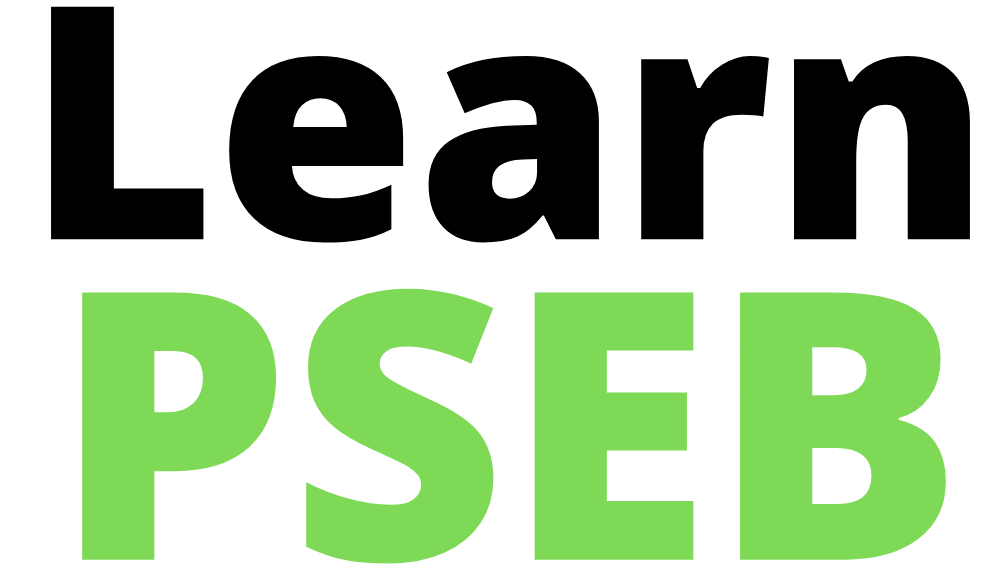PSEB Class 10 Biology Solutions For Chapter Chapter 5: Our Environment
Ecosystem
A system consisting of all living organisms and their physical environment, functioning together as a unit, is called an ecosystem.
Flow Chart Of Components Of Ecosystem
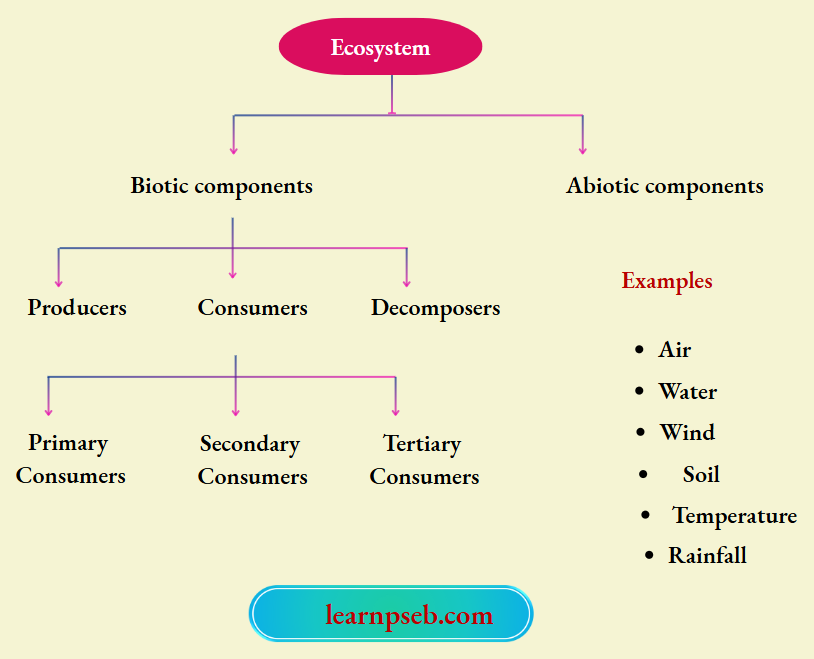
Flow Chart Of Biotic Components
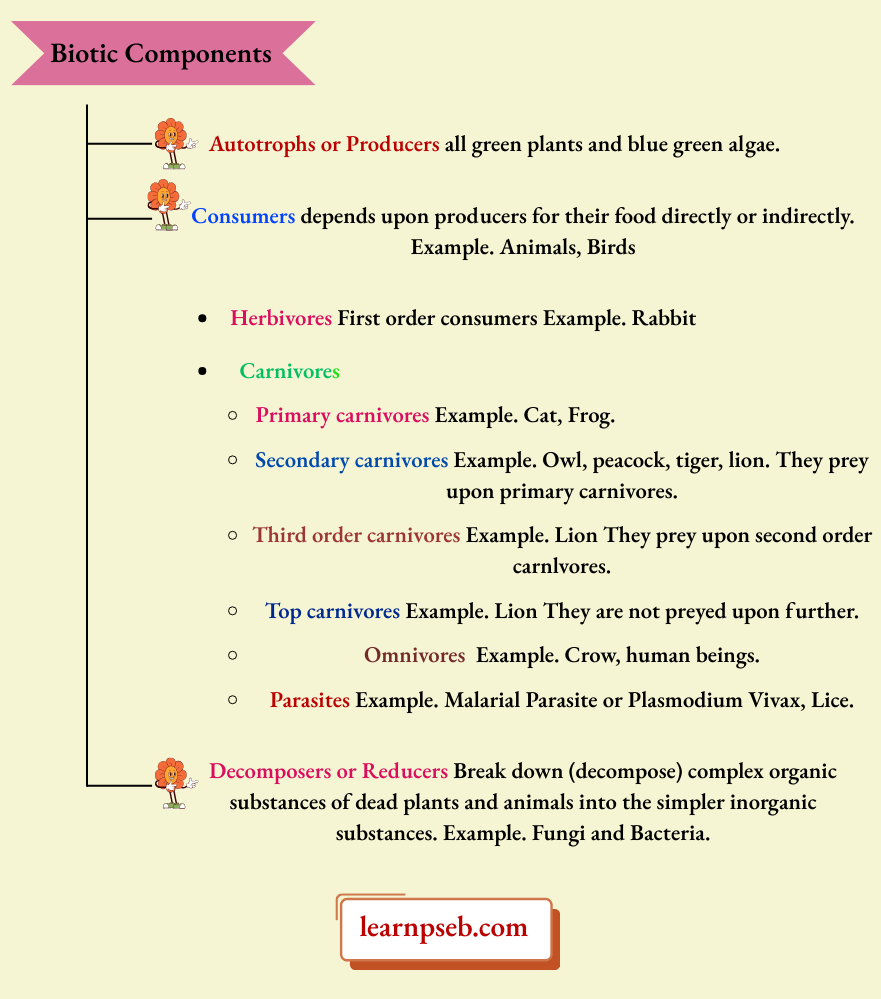
Importance Of Decomposers
- Act as Natural Scavengers by disposing of the wastes and dead bodies of plants and animals. In this way decomposers clean the environment and create space for a living of newer generations of organisms.
- Help in Maintaining Fertility of Soil by releasing minerals and other raw materials trapped in organic matter into the soil.
- Decomposers produce some acids which are useful in solubilization of some minerals.
- Decomposers help in recycling the materials in the biosphere.
Types Of Ecosystems
Two types, viz. Natural Ecosystem and Artificial Ecosystem.
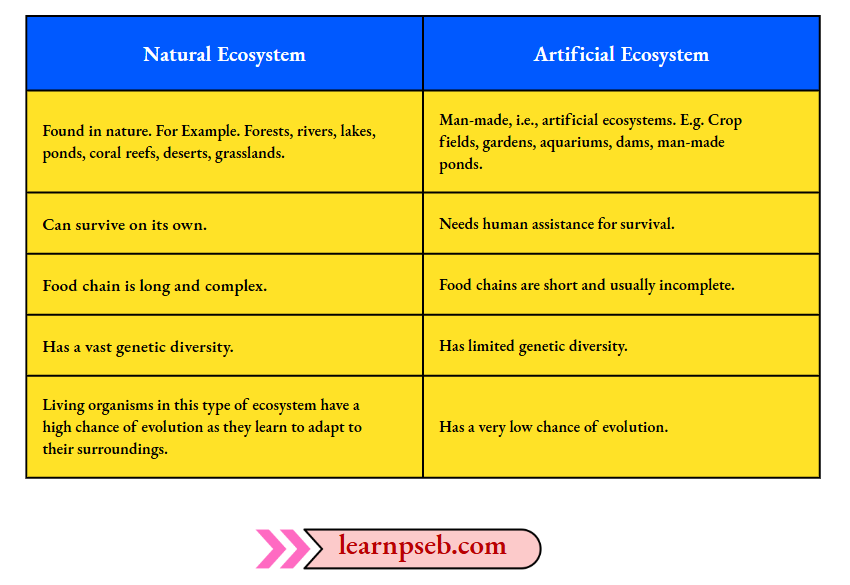
Food Chain
A food chain describes the flow of energy and nutrients through an ecosystem.
Read And Learn More PSEB Class 10 Biology
Important Points About Food Chain
1. Flow of energy in a food chain is unidirectional as shown in diagram.
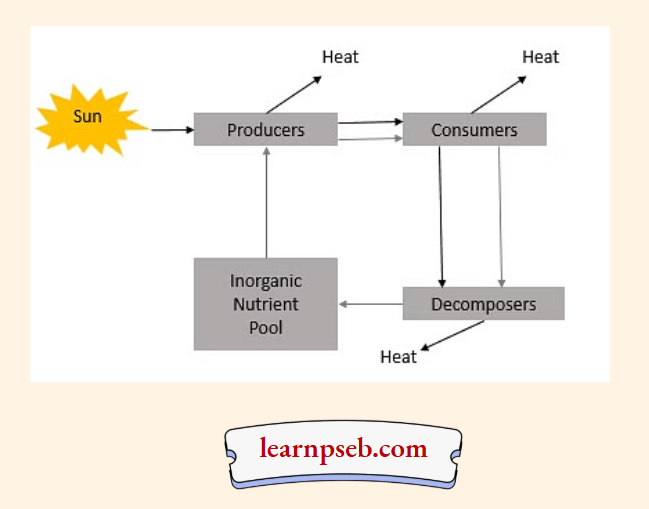
2. Each step or level of the food chain forms a trophic level. Flow of energy in trophic levels of a food chain obeys TEN PERCENT LAW.
According to Ten Percent Law law, there is a gradual decrease in the amount of energy transfer from one trophic level to the next trophic level in a food chain, i.e., only 10% of energy is transferred to next trophic level while 90% of energy is used by that particular trophic level in its life processes. This is shown in diagram below:
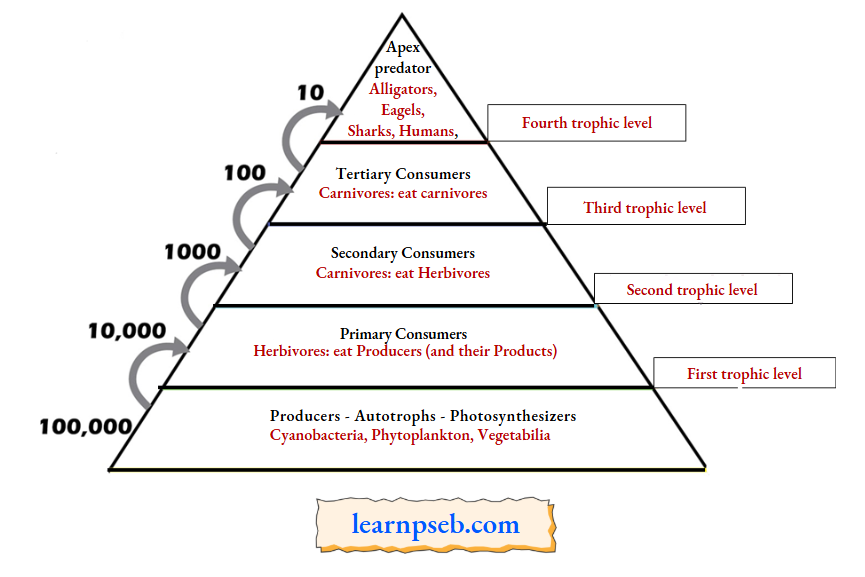
3. Since very less amount of energy is available for the next level of consumers, food chains generally consist of only three or four steps.
4. There are generally a greater number of individuals at the lower trophic levels than at the higher trophic levels.
Food Web – It is defined as a network of organisms which are dependent on each-other.

Difference Between Food Chain And Food Web

Biological Magnification
The increase in concentration of harmful chemical substances like pesticides in the body of living organisms at each trophic level of a food chain is called biological magnification.
An example of biological magnification indicating increase in mercury concentration in aquatic life and humans is provided below:
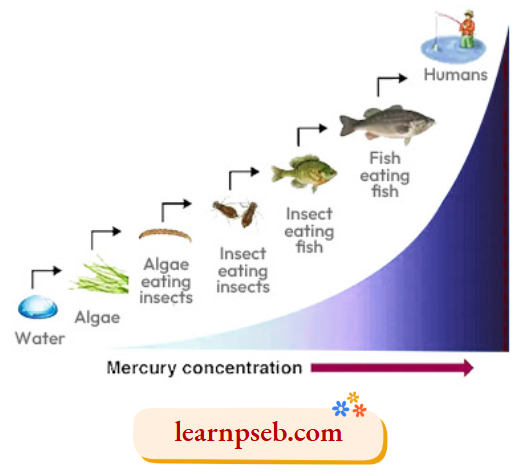
Since human beings occupy the top level in any food chain, the maximum concentrations of these chemicals get accumulated in our bodies.
Environmental Problems – Two main causes of environmental problems are:
- Changes in Environment
- Human Activities
Major Environmental Problems
Depletion of Ozone layer and Pollution (Waste or Garbage Disposal).
Ozone Layer Depletion
- Ozone layer depletion means the thinning of the ozone layer present in the upper atmosphere.
- The decline of Ozone layer thickness in Antarctica was first discovered in 1985 and was termed as OZONE HOLE.
- Ozone Layer Depletion primarily occurred due to excessive use of CFCs (Chloro Flouro Carbon. Freon) used as refrigerants and also in fire extinguishers. It also occurs due to environmental pollution.
- Although ozone is deadly poison, ozone, present at the higher levels of atmosphere, shields the surface of the earth from ultraviolet (UV) radiation from the Sun. Ozone is essential for all aerobic forms of life. Thus, ozone is essential for survival of forms of life in one wav or the other.
- At the higher levels of the atmosphere, higher energy UV radiations split apart some oxygen molecules (O2) into free oxygen (O) atoms. These atoms then combine with the other oxygen molecules to form ozone.
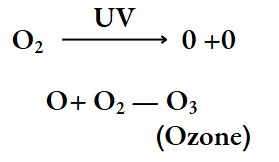
This Ozone, present at the higher levels of atmosphere, shields the surface of the earth from ultraviolet (UV) radiation from the Sun.
However, due to atmospheric pollution, the thickness of the ozone layer is depleting, resulting in poor shielding from UV rays.
Steps Taken To Control Ozone Layer Depletion
In 1987, an agreement was arrived at the United Nations Environment Program (UNEP) with regards to freezing CFC production at 1986 levels.
- It is now mandatory for all the manufacturing companies to make CFC-free refrigerators throughout the world.
- Modern refrigerators usually use a refrigerant called HFC-134a (1.1,1.2-Tetrafluoroethane) instead of Freon. It does not deplete the ozone layer.
Garbage Disposal
Materials generated during our daily activities and in industrial processes that are not useful to us are called waste materials. They can be broadly categorized into two categories, viz. Biodegradable waste and Non-Biodegradable waste.
Differences Between Biodegradable And Non-Biodegradable Waste
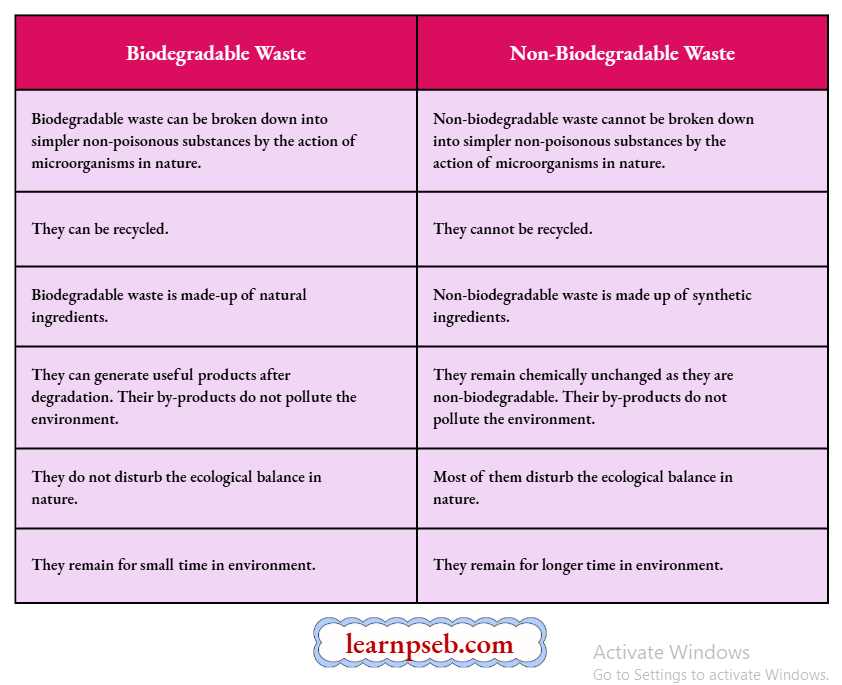
5R’S To Save The Environment
- Refuse means “saying no” to the use of materials which have a harmful effect on the environment. For Example. No to plastics.
- Reduce means we should minimise our use of natural resources, sources of energy and food materials.
- Recycle means that we should collect materials like paper, plastics, glass and metal items. These waste materials should be recycled to obtain these materials again for use.
- Reuse means to encourage to use things again and again instead of throwing them away. For Example. plastic bottles .Re-use is better than recycling as it saves energy.
- Repurpose means using the waste product if one material as an input material for the production of some other material, For Example. Sugarcane waste obtained from sugar industry is being used for the manufacture of paper.
Chapter 5 Our Environment Reason- Assertion Questions And Answers
Following questions consist of two statements – Assertion (A) and Reason (R). Answer these questions selecting the appropriate option given below:
- Both ‘A’ and ‘R’ are true and ‘R’ is correct explanation of the Assertion.
- Both ‘A’ and ‘R’ are true but ‘R’ is not correct explanation of the Assertion.
- ‘A’ is true but ‘R’ is false.
- ‘A’ is false but ‘R’ is true.
Question 1. Assertion (A): Polythene bags and plastic containers are non-biodegradable substances.
Reason (R): They can be broken down by microorganisms in natural simple harmless substances.
Answer: 3. ‘A’ is true but ‘R’ is false.
Question 2. Assertion (A): The concentration of harmful chemicals is least in human beings.
Reason (R): Man is at the apex of the food chain.
Answer: 4. ‘A’ is false but ‘R’ is true.
Question 3. Assertion (A): Ozone is formed in upper atmosphere by 02 in presence of UV radiations.
Reason (R): Ozone depletion will lead to UV rays reaching earth which may cause skin cancer.
Answer: 2. Both ‘A’ and ‘R’ are true but ‘R’ is not correct explanation of the Assertion.
Question 4. Assertion (A): The various components of an ecosystem are interdependent
Reason (R): Food chain and web are formed due to linkage in organisms.
Answer: 1. Both ‘A’ and ‘R’ are true and ‘R’ is correct explanation of the Assertion.
Question 5. Assertion (A): Each step in a food chain is called a trophic level.
Reason (R): Trophic levels are formed by both plants and animals.
Answer: 1. Both ‘A’ and ‘R’ are true and ‘R’ is correct explanation of the Assertion.
Question 6. Assertion (A): Food web consists of only producers.
Reason (R): Specific enzymes are required for breakdown of substances in environment.
Answer: 4. ‘A’ is false but ‘R’ is true.
Question 7. Assertion (A): The function of consumers is to convert organic compound into inorganic compound.
Reason (R): Green plants are called the producers.
Answer: 4. ‘A’ is false but ‘R’ is true.
Chapter 5 Our Environment Case Or Source Based Questions And Answers
Question 1. Plastic bags cause many minor and major ecological and environmental issues. The most general issue with plastic bags is the amount of waste produced. Many plastic bags end up on streets and subsequently pollute major water sources, rivers, and streams. Even when disposed of properly, they take many years to decompose and break down, generating large amounts of garbage over long periods of time. Improperly discarded bags have polluted waterways, clogged sewers and been found in oceans, affecting the ecosystem of marine creatures.
1) Which of the following is non-biodegradable?
- Plastic
- Tea leaves
- Spoilt bread
- Paper
Answer: 1. Plastic
2) Which of the following is likely to cause most pollution?
- Plastic cups
- Paper bags
- Dried leaves
- Broken glassware
Answer: 1. Plastic cups
3) What is the most general issue with plastic bags?
- They are biodegradable
- They are heavy
- They produce a lot of waste
- They are cheaper.
Answer: 3. They produce a lot of waste
4) Which of the following is the effect of plastic pollution?
- Clogging of drains
- Death of marine life
- Loss of aesthetic beauty
- All of these
Answer: 4. All of these
5) Which of the following is the most eco-friendly option?
- Use of paper bags for shopping
- Use of steel plates for dining
- Use of kulhads for tea
- All of these
Answer: 4. All of these
Question 2. All living things need air to breathe. Contamination of air with particles, gases and chemicals that have the potential to adversely affect the health of humans and animals, vegetation and human assets is called air pollution. Major air pollutants are SO2, nitrogen oxides, CO, CFCs, etc. Refer to the given graph showing air quality of three cities.
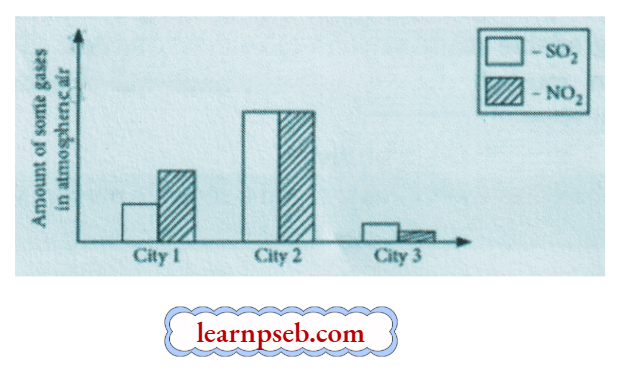
- What can be inferred from the given graph?
- What will be the effect of high concentration of SO2 and NO2 in atmospheric air of city 2?
- What are the harmful effects of acid rain?
Answer:
- Air of city 2 is most polluted as maximum amount of oxides of sulphur and nitrogen are present in its atmospheric air.
- When the rainwater contains large quantities of acids like nitric acid and sulphuric acid formed by dissolution of oxides of nitrogen and sulphur in water it is called acid rain.
- Acid rain damages the foliage thereby decreasing the growth and yield of plants. Soil microbes get killed due to low pH of the soil and results in disturbing the terrestrial ecosystem. Buildings and monuments get corroded and damaged.
Question 3. Several interconnected food chains form a food web. A food web is similar to a food chain but the food web is comparatively larger than a food chain. When there are more cross interactions between different food chains, the food web gets more complex. This complexity in a food web leads to a more sustainable ecosystem.
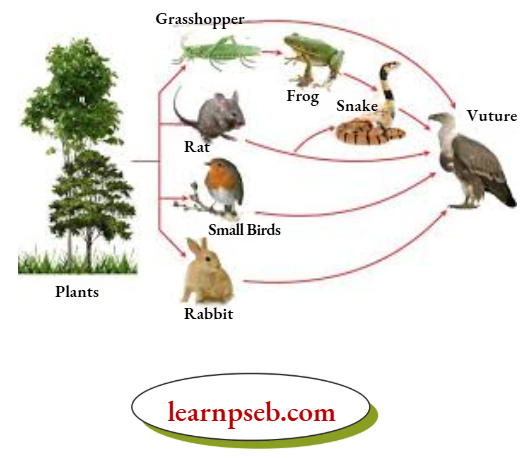
1) Which living being occupies the lowest level in the above web?
Plants
Small birds
Frog
Vulture
Answer: 1. Plants
2) What forms the food of a snake?
- Frog and small birds
- Rat and frog
- Small birds and grasshopper
- Grasshopper and rat
Answer: 2. Rat and frog
3) Which link would get directly disturbed if the population of grasshopper is wiped out?
- Frog
- Snake
- Vulture
- Small birds
Answer: 1. Frog
4) Which organisms in the above food web do not act as herbivores?
- Small birds
- Grasshoppers
- Rat
- Snake
Answer: 4. Snake
5) In the given food web, vulture is said to be
- Herbivore
- Omnivores
- Apex carnivore
- Producer
Answer: 3. Apex carnivore
Question 4. Raman went to picnic with her friends to a nearby park. All of them took with themselves, eatables packed either in aluminium foils, polythenes, paper bags, plastic bottles, cans or in paper cups. They enjoyed their picnic and when teacher called them to be ready for going back, her friends picked up their bags and left all the waste material scattered here and there. But, Raman called them and asked each one to pick up the left over things and put them in the bins marked ‘biodegradable’ and ‘nonbiodegradable’. She also explained the advantages of doing so. Her friends accepted her advice and cleaned the park. Read the given passage and answer the following questions:
- Mention the value reflected by Raman’s initiative.
Answer:
- Raman is good observer, takes initiative and a sensible person, who applies and understands the value of nature.
Question 5. Rohit got into a quarrel with some farmers who were spraying DDT in their field. Many people gathered at the spot to see and enjoy the incident. The angry mob demanded that Rohit should not interfere with the farmers’ job. Rohit tried to explain his point and finally succeeded. The farmers gave up spraying DDT.
- What did Rohit explain to the farmers?
- What is biomagnification? Explain with an example.
- What values did Rohit promote?
Answer:
- Rohit explained the health hazards of using DDT on our environment and other animals to farmers, i.e. DDT is a non-biodegradable substance and it persists in environment for long time and cause environmental pollution, DDT could enter into a food chain and everyone associated would be affected due to its accumulation in their body.
- Biomagnification refers to increase in concentration of the toxicant at successive trophic levels. This happens because this toxic substance gets accumulated in the organism which cannot be metabolised or excreted and is thus, passed onto the next higher trophic level.
- Rohit promotes health awareness, eco-friendly nature, sympathy and determination to support the right cause.
